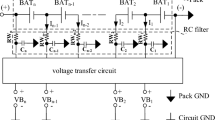Abstract
The design of a novel Li-ion battery charger using multi-mode LDO architecture has been introduced in this paper. The proposed architecture, using an improved multi-mode LDO, not only obtains high accuracy but also reduces power supply noise because of utilizing novel error amplifier and power buffer configuration; while still consuming low power dissipation. To obtain the low power consumption, the Schmitt Trigger technique is applied to the charging controller and an optimized current driven circuit is proposed. Besides, the PSRR parameter is also enhanced by adding pre-regulation circuit in multi-mode LDO circuit. Thus, the proposed Li-ion battery charger achieves 700 mA operation current with 70.9 % efficiency but only dissipates 495 mW in power. During the charging process, the setting time and ripple issues are solved by the use of soft-start circuit which is integrated into the charging controller in order to decrease the chip area. Therefore, the setting time is reduced to 5.5 μs while gaining the load regulation at approximately 0.019 μV/mA and increasing PSRR up to 106 dB at DC level. Moreover, the line regulation is also reduced at 1.3 mV/V. The proposed linear battery charger is designed and implemented, based on High-Voltage CMOS process with using 4.5 V power supply voltage and obtaining 4.2 V battery output voltage.















Similar content being viewed by others
References
Brown, M. (2001). Power supply cookbook (2nd ed.). Woburn: Newnes.
Keeping, S. (2012). Understanding the advantage and disadvantage of linear regulators. Electronic Product, Digikey Article Library.
Al-Shyoukh, M., & Lee, H. (2009). A compact ramp-based soft-start circuit for voltage regulators. IEEE Transaction on Circuit and System II, 56(07), 535–539.
Gregoire, B. R. (2006). A compact switched-capacitor regulated charge pump power supply. IEEE Journal of Solid-State Circuits, 41(8), 1–9.
Hwang, Y.-S., Wang, S.-C., Yang, F.-C., Chen, J.-J., & Lee, W. T. (2006). New Li-ion batery charge based on charge pump technique. In IEEE International Conference on Comunication, Circuit and System (pp. 2259–2262).
Hwang, Y.-S., Wang, S.-C., Yang, F.-C., & Chen, J.-J. (2007). New compact Li-ion battery charger using charge pump techniques for portable appications. IEEE Journal of Solid-State Circuits, 54(4).
Do Valle, B., Wentz, C. T., & Sarpeshkar, R. (2011). An area and power-efficient analog Li-ion battery charger circuit. IEEE Transaction on Biomedical and Systems, 5(2), 131–137.
Sun, Y., Wu, X., & Zhao, M. (2009). Li-ion battery charger with smooth-switch-over four-stage control. In International Symposium on Integrated Circuit (pp. 49–52).
Pagano, R., Baker, M., & Radke, R. E. (2012). A 0.18-μm monolithic Li-ion batter charger for wireless devices based on partial current sensing and adaptive reference voltage. IEEE Journal of Solid State Circuits, 47(6), 1355–1368.
Chen, M., & Rincon-Mora, G. A. (2006). Accurate, compact, and power-efficient Li-ion battery charger circuit. IEEE Transactions on Circuit and System II, 11(53), 1180–1184.
Tsai, C.-C. (2013). A reduced Li-ion battery charger for portable application. In IEEE 9th International Conference on Natural Computation (ICNC) (pp. 1718–1722).
Chen, J.-J., Yang, F.-C., Lai, C.-C., Hwang, Y.-S., & Lee, R.-G. (2009). A high-efficiency multimode Li-ion battery charger with variable current source and controlling previous-stage supply voltage. IEEE Transaction on Industrial Electronics, 56(07), 2469–2478.
Jiana, L., Xiaobo, W., & Menglian, Z. (2010). Switch-mode multi power supply Li-ion battery charger with power path management. In IEEE 10th International Conference on Solid-State and Integrated Circuit Technology (ICSICT) (pp. 527–529).
Yang, H.-Y., Wu, T.-H., Chen, J.-J., Hwang, Y.-S., & Yu, C.-C. (2013). An omnipotent Li-ion battery charger with multimode controlled techniques. In IEEE 10th Conference on Power Electronics and Drive Systems (PEDS) (pp. 531–534).
Van Quang, P. H., Ha, T. T., & Lee, J.-W. (2014) A fully integrated multimode wireless power charger IC with adaptive supply control and built-in resistance compensation. IEEE Transaction on Industrial Electronics, (Editing).
Tsai, C.-C., Lin, C.-Y., Hwang, Y.-S., Lee, W.-T., & Lee, T.-Y. (2004). A multi-mode LDO based Li-ion battery charger in 0.35 μm CMOS technology. In IEEE Asia-Pacific Conference on Circuit and Systems (pp. 49–52).
Milliken, R. J., Silva-Martinez, J., & Sanchez-Sinecio, E. (2007). Full CMOS low-dropout voltage regulator. IEEE Transaction on Circuit and System I, 54(9), 1879–1890.
Teofilo, V. L., Merrit, L. V., & Hollandsworth, R. P. (1997). Advance Lithium Ion battery charger. IEEE AES System Magazines, 30–35.
Dearborn, S. (2015). Charging Li-ion batteries for maximun run times. Power Electronics Technology Magazines, 40–49.
Alen, P. E., & Holberg, D. R. (2002). CMOS analog circuit design. New York: Oxford University Express.
Foty, D. (1997). MOSFET modeling with SPICE: Principle and practice (pp. 154–266). New York: Prentice Hall PTR.
Gray, P. R., et al. (2009). Analysis and design of analog integrated circuits (5th ed.). Hoboken: IEEE Press Wiley.
Shibata, K., & Pham, C.-K. (2010). A DC-DC converter using a high speed soft-start control circuit. In IEEE International Symposium on Circuit and System (ISCAS) (pp. 833–836).
Hentunen, A., Lehmuspelto, T., & Soumela, J. (2014). Time-domain parameter extraction method for Thvenin equivalent circuit battery models. IEEE Transaction on Energy Conversion, 29(03), 558–566.
Lou, W., Lv, C., Wang, L., & Liu, C. (2011) Study on impedance model of Li-ion battery. In 6th IEEE Conference on Industrial Electronics and Applications (ICIEA) (pp. 1943–1947).
Chen, M., & Rincon-Mora, G. A. (2006). Accurate electrical battery model capable of predicting runtime and I-V performance. IEEE Transaction on Energy Conversion, 21(02), 504–511.
De Lima, J. A. (2014). A compact and power-efficienct CMOS battery charger for implantable devices. In 27th Symposium on Integrated Circuit and System Design (SBCCI), Aracju.
Author information
Authors and Affiliations
Corresponding author
Rights and permissions
About this article
Cite this article
Nguyen, H.M., Pham, L.D. & Hoang, T. A novel Li-ion battery charger using multi-mode LDO configuration based on 350 nm HV-CMOS. Analog Integr Circ Sig Process 88, 505–516 (2016). https://doi.org/10.1007/s10470-016-0778-1
Received:
Revised:
Accepted:
Published:
Issue Date:
DOI: https://doi.org/10.1007/s10470-016-0778-1




